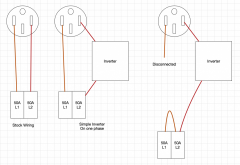Intro: Okay so I know this is a big endeavor, but amid all that is happening in the world I want to set up my 5th wheel to be self sufficient but not have any of the draw backs I normally see. Often times this is the AC and Heater Limitations, I also have some electric bikes to charge as well as dehumidifier to capture water out of the air for water supply I feel with the proper solar array and Eve battery system this could be pulled off.
I actually work for the worlds most efficient solar panel manufacturer and installer so I do have some back ground in solar, but its more towards a grid tied system that can support a good bit of panels and the batteries aren't even made to run AC or water heater.. Plus I cant even buy the damn panels from my company any ways...
What I am working with is a 2021 Jayco north point 377rlbh wife and 2 kids, and I want to make sure I can still plug it into shore power. I am toying with the new Victron Inverter RS 48/6000 with a Victron autotransformer, I don't see my self ever needing more that 5kw of power at any one time and the fact it does a peak of 9kw is enough for the ac to kick on and do its thing, its a pretty much all in one solution that seems to be very efficient. But i dont know how a shore power system would integrate with that... thus a quatro is being considered as well but those are so heavy and bulky and would still need to have a charge controller to function properly.
Thus, I am turning to yall because I have a fair bit of ideas to throw around to see if any of them make sense.
1) An answer to the above mentioned predicament
2)Any way to modify an electric car like a Tesla or other manufacturer that could act as the battery for the 5th wheel?
3) I want this to be a mobile solution and doubt a pure flat mount solar system could supply the power I need to run the mother-ship so which would make most sense? A) automated tilting system? B) Slides to get more panels on the roof? my concern is weight and complexity for this...
4) Battery sizing is alittle tough for me with it being completely off the grid, im thinking a 30kwh... but might need larger? i know alot of people would just keep a generator on hand for the times extra power is needed and i would agree i plan to have one... but I am really trying to have a system that can pretty much do everything on its own, in case fuel is ever an issue
I actually work for the worlds most efficient solar panel manufacturer and installer so I do have some back ground in solar, but its more towards a grid tied system that can support a good bit of panels and the batteries aren't even made to run AC or water heater.. Plus I cant even buy the damn panels from my company any ways...
What I am working with is a 2021 Jayco north point 377rlbh wife and 2 kids, and I want to make sure I can still plug it into shore power. I am toying with the new Victron Inverter RS 48/6000 with a Victron autotransformer, I don't see my self ever needing more that 5kw of power at any one time and the fact it does a peak of 9kw is enough for the ac to kick on and do its thing, its a pretty much all in one solution that seems to be very efficient. But i dont know how a shore power system would integrate with that... thus a quatro is being considered as well but those are so heavy and bulky and would still need to have a charge controller to function properly.
Thus, I am turning to yall because I have a fair bit of ideas to throw around to see if any of them make sense.
1) An answer to the above mentioned predicament
2)Any way to modify an electric car like a Tesla or other manufacturer that could act as the battery for the 5th wheel?
3) I want this to be a mobile solution and doubt a pure flat mount solar system could supply the power I need to run the mother-ship so which would make most sense? A) automated tilting system? B) Slides to get more panels on the roof? my concern is weight and complexity for this...
4) Battery sizing is alittle tough for me with it being completely off the grid, im thinking a 30kwh... but might need larger? i know alot of people would just keep a generator on hand for the times extra power is needed and i would agree i plan to have one... but I am really trying to have a system that can pretty much do everything on its own, in case fuel is ever an issue




